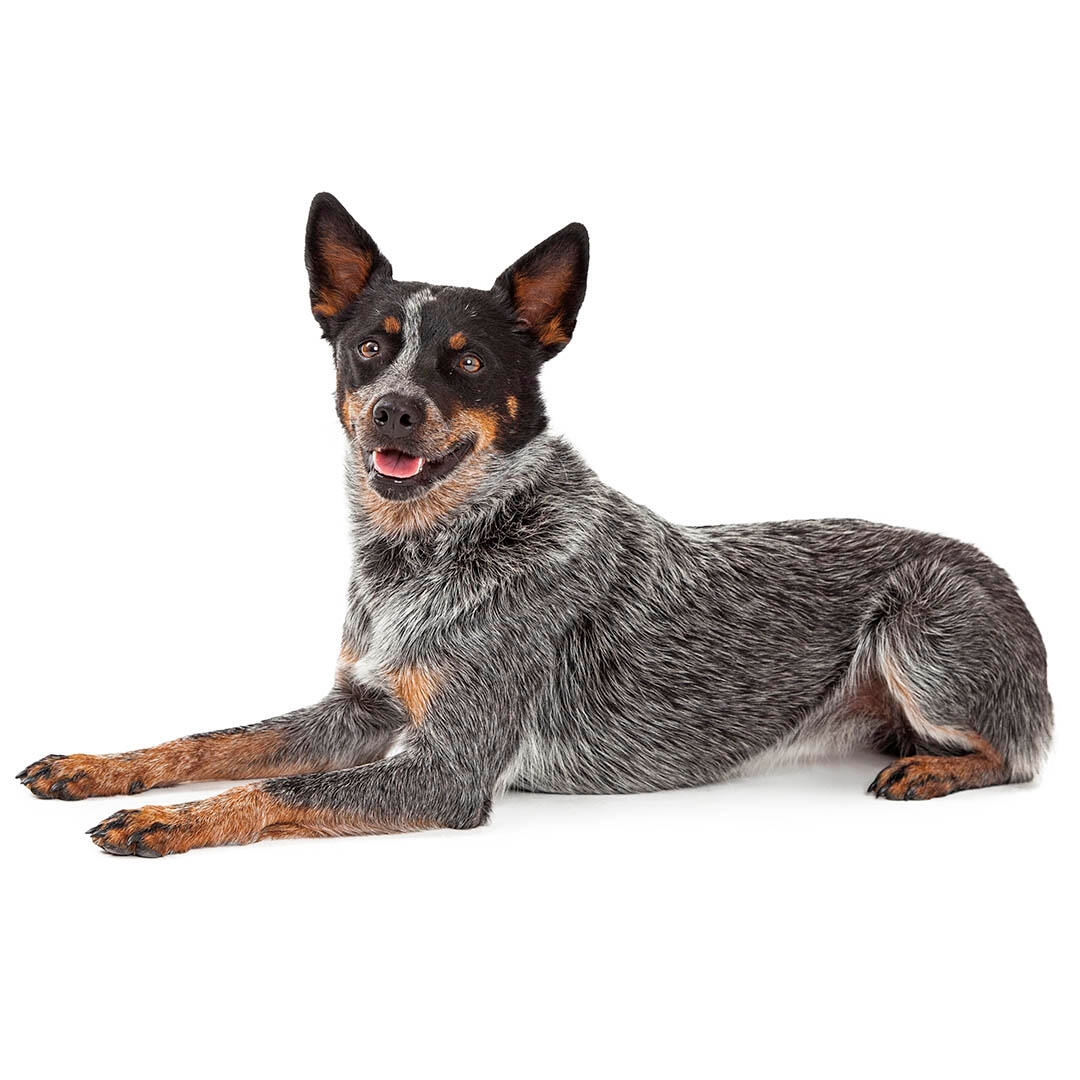
| Family-friendly: | 4/5 |
| Exercise needs: | 5/5 |
| Easy to train: | 5/5 |
| Tolerates being alone: | 3/5 |
| Likes other pets: | 4/5 |
| Energy level: | 5/5 |
| Grooming needs: | 3/5 |
| Shedding: | 3/5 |
The Australian Cattle Dog can be prone to:
- Hip dysplasia
- Elbow dysplasia
- Portosystemic shunt which is a condition where the blood does not pass through the liver normally, which leads to toxin build-up.
- Congenital deafness
- Eczema which is a problem where the skin can become sore and itchy, often triggered by an allergen.
- Glaucoma¹ which is a painful condition where the pressure in the eye builds up.
- Progressive retinal atrophy which is an inherited disorder where part of the eye degenerates and wastes away which can result in blindness.
- Urolithiasis which is when stones form in the urinary tract and can cause pain.
Priority Kennel Club health schemes and testing:
- DNA test for progressive retinal atrophy which tests whether or not a dog has the potential to be affected by this condition.
- Eye screening scheme
¹D. A. J. Johnsen, D. J. Maggs & P. H. Kass, 'Evaluation of risk factors for development of secondary glaucoma in dogs: 156 cases (1999–2004)', October 2006, Vol. 229, No. 8, Pages 1270-1274, Abstract Journal of the American Veterinary Medical Association, https://doi.org/10.2460/javma.229.8.1270
Smart and quick to react, the Aussie is a very fast learner, but their tendency to use their teeth to move other animals (including humans) can be an issue. Early socialisation and training to encourage a softer mouth is necessary. Naturally wary of strangers and very willing to guard and alert via barking, this is a breed that needs plenty of training and experienced owners, but will reward that by being a loyal, hard-working companion.
| Family-friendly: | 4/5 |
| Exercise needs: | 5/5 |
| Easy to train: | 5/5 |
| Tolerates being alone: | 3/5 |
| Likes other pets: | 4/5 |
| Energy level: | 5/5 |
| Grooming needs: | 3/5 |
| Shedding: | 3/5 |
Australian stockmen in the late 1800’s found that the Collies imported to Australia were not tough enough for the harsh conditions and bold livestock. Over 60 years of crossbreeding, including Dingo, collie, sheepdog, Kelpie, Dalmatian and Bull Terrier went into producing the Australian Cattle dog. These efforts produced a clever yet biddable dog who could use their own initiative when needed, working tough livestock in very difficult conditions.
Australian Cattle dogs also go by the name ‘Heeler’ which refers to their working practice of nipping at the heels of the cattle they are driving.
The best possible owner for the Aussie Cattle Dog is someone who lives rurally and spends a lot of the day walking or riding to check on and move cattle. If you can’t provide cattle, then long walks and time spent herding giant exercise balls or taking part in competitive dog sports will suffice for this tough, workaholic dog.
The Australian Cattle dog needs at least two hours exercise per day, including mental stimulation and training. They have great stamina and endurance and will happily accept much more. This is a very agile dog, and an independent thinker, it is better not to leave them unsupervised or bored for long!
The Australian Cattle Dog is not difficult to house, providing outdoor space is securely fenced. They have been bred to work out how to get around or over obstacles in the course of their work, and so are excellent escape artists and very skilled counter-top opportunists!
Given their natural desire to react to movement and control moving objects, this is a breed better kept away from busy roads and bustling pavements. Quiet rural or farm homes will suit this breed much better than town or city.
Your dog's diet needs to have the right balance of all the main nutrient groups including a constant supply of fresh water. It's important to conduct regular body condition scores to ensure you keep your dog in ideal shape and remember to feed him at least twice daily and in accordance with the feeding guidelines of his particular food.
Hard wearing and easy to maintain, the Australian Cattle Dog needs brushing weekly to bring out dead hair. If wet and muddy, allow to dry and the dirt will easily brush off. It is always a good idea to get any dog used to grooming from an early age, no matter how low maintenance their coat, and paws and ears should be checked daily for foreign bodies such as thorns or grass seeds.
The Aussie is a dog who will enjoy a variety of dog sports (especially agility) and activities and thrives on training and working closely with their person. Finding an activity this breed excels at is not difficult, teaching them to relax and switch off may be harder. Early work on teaching a soft mouth, and not to chase or nip is essential.
The Australian Cattle Dog is a herder, they prefer that groups of animals, including people, stay together and move along at a pace they dictate. With adults and older children who can be involved in training this can be overcome, but younger families and those with toddlers will find this difficult. This breed requires a lot of time to exercise and train which may conflict with family time commitments.
While many dogs are traditionally thought of as being good with children, all dogs and children need to be taught to get on with and respect each other, and be safe together. Even so, dogs and young children should never be left alone together and adults should supervise all interactions between them.